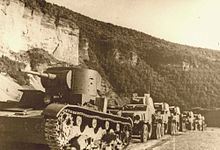
Back الاحتلال السوفيتي لبيسارابيا وبوكوفينا الشمالية Arabic Далучэнне Бесарабіі і Паўночнай Букавіны да СССР Byelorussian Съветска окупация на Бесарабия и Северна Буковина Bulgarian Sowjetische Besetzung Bessarabiens und der Nordbukowina German Ocupación soviética de Besarabia y el norte de Bucovina Spanish Besarabia eta Ipar Bukovinaren sobietar okupazioa Basque اشغال بسارابیا و بوکوفینای شمالی توسط شوروی Persian Occupation soviétique de la Bessarabie et de la Bucovine du Nord French הסיפוח הסובייטי של בסרביה ובוקובינה הצפונית HE Pendudukan Bessarabia dan Bukovina Utara oleh Uni Soviet ID
| Soviet occupation of Bessarabia and Northern Bukovina | |||||||
|---|---|---|---|---|---|---|---|
| Part of the military occupations by the Soviet Union | |||||||
 Soviet parade in Chișinău, 4 July 1940 | |||||||
| |||||||
| Belligerents | |||||||
|
|
| ||||||
| Strength | |||||||
|
| ||||||
| Casualties and losses | |||||||
|
| ||||||
| |||||||
Between 28 June and 3 July 1940, the Soviet Union occupied Bessarabia and Northern Bukovina, following an ultimatum made to Romania on 26 June 1940 that threatened the use of force.[2] Those regions, with a total area of 50,762 km2 (19,599 sq mi) and a population of 3,776,309 inhabitants, were incorporated into the Soviet Union.[3][4] On 26 October 1940, six Romanian islands on the Chilia branch of the Danube, with an area of 23.75 km2 (9.17 sq mi), were also occupied by the Soviet Army.[5]
The Soviet Union had planned to accomplish the annexation with a full-scale invasion, but the Romanian government, responding to the Soviet ultimatum delivered on 26 June, agreed to withdraw from the territories to avoid a military conflict. The use of force had been made illegal by the Conventions for the Definition of Aggression in July 1933, but from an international legal standpoint, the new status of the annexed territories was eventually based on a formal agreement through which Romania consented to the retrocession of Bessarabia and cession of Northern Bukovina. As it was not mentioned in the ultimatum, the annexation of the Hertsa region was not consented to by Romania, and the same is true of the subsequent Soviet occupation of the Danube islands.[2] On 24 June, Nazi Germany, which had acknowledged the Soviet interest in Bessarabia in a secret protocol to the 1939 Molotov–Ribbentrop Pact, had been made aware prior to the planned ultimatum but did not inform the Romanian authorities and was unwilling to provide support.[6] On 22 June, France, a guarantor of Romanian borders, fell to Nazi advances. This is considered to be an important factor in the Soviets' decision to issue the ultimatum.[7] The Soviet invasion of Bukovina in 1940 violated the Molotov-Ribbentrop Pact, since it went beyond the Soviet sphere of influence that had been agreed with the Axis.[contradictory][8]

On 2 August 1940, the Moldavian Soviet Socialist Republic was proclaimed as a constituent republic of the Soviet Union, encompassing most of Bessarabia and part of the Moldavian Autonomous Soviet Socialist Republic, an autonomous republic of the Ukrainian Soviet Socialist Republic on the left bank of the Dniester (now the breakaway Transnistria). The Hertsa region and the regions inhabited by Slavic majorities (Northern Bukovina, Northern and Southern Bessarabia) were included in the Ukrainian SSR. A period of political persecution, including executions, deportations to labour camps and arrests, occurred during the Soviet administration.
In July 1941, Romanian and German troops occupied Bessarabia, Northern Bukovina and Hertsa during the Axis invasion of the Soviet Union. A military administration was established, and the region's Jewish population was executed on the spot or deported to Transnistria, where large numbers were killed. In August 1944, during the Soviet Second Jassy–Kishinev Offensive, the Axis war effort on the Eastern Front collapsed. The coup of 23 August 1944 caused the Romanian army to cease resisting the Soviet advance and to join the fight against Germany. Soviet forces advanced from Bessarabia into Romania, captured much of its standing army as prisoners-of-war and occupied the country.[9] On 12 September 1944, Romania signed the Moscow Armistice with the Allies. The Armistice and the subsequent peace treaty of 1947 confirmed the Soviet-Romanian border as it was on 1 January 1941.[10][11]
Bessarabia, Northern Bukovina and Hertsa remained part of the Soviet Union until it collapsed in 1991, when they became part of the newly independent states of Moldova and Ukraine. The Declaration of Independence of Moldova of 27 August 1991, declared the Soviet occupation illegal.[12]
- ^ Olaru-Cemârtan, Viorica (2020). Teroarea stalinistă în RSSM, 1940–1941, 1944–1956: deportările, exilările în Gulag, foametea. Chișinău: Editura LEXON SRL.
- ^ a b Deletant 2006, p. 20.
- ^ King 2000, pp. 91–95
- ^ "Final Report of the International Commission on the Holocaust in Romania" (PDF). United States Holocaust Memorial Museum. Retrieved 17 March 2018.
- ^ Motoc 2018, p. 216.
- ^ Bossy, G.H., Bossy, M-A. Recollections of a Romanian Diplomat, 1918–1969, Volume 2, Hoover Press, 2003.
- ^ Joseph Rothschild, East Central Europe between the two World Wars University of Washington Press, Seattle, 1977; ISBN 0-295953-57-8, p.314
- ^ Brackman, Roman The Secret File of Joseph Stalin: A Hidden Life (2001) p. 341
- ^ James Stuart Olson; Lee Brigance Pappas; Nicholas Charles Pappas (1994). An Ethnohistorical Dictionary of the Russian and Soviet Empires. Greenwood Publishing Group. p. 484. ISBN 9780313274978.
- ^ "The Armistice Agreement with Rumania; September 12, 1944". The Avalon Project. Retrieved 17 March 2018.
- ^ United States Department of State. Foreign relations of the United States, 1946. Paris Peace Conference: documents Volume IV (1946)
- ^ "Declaration of Independence of the Republic of Moldova". Archived from the original on 30 August 2013. Retrieved 17 March 2018.